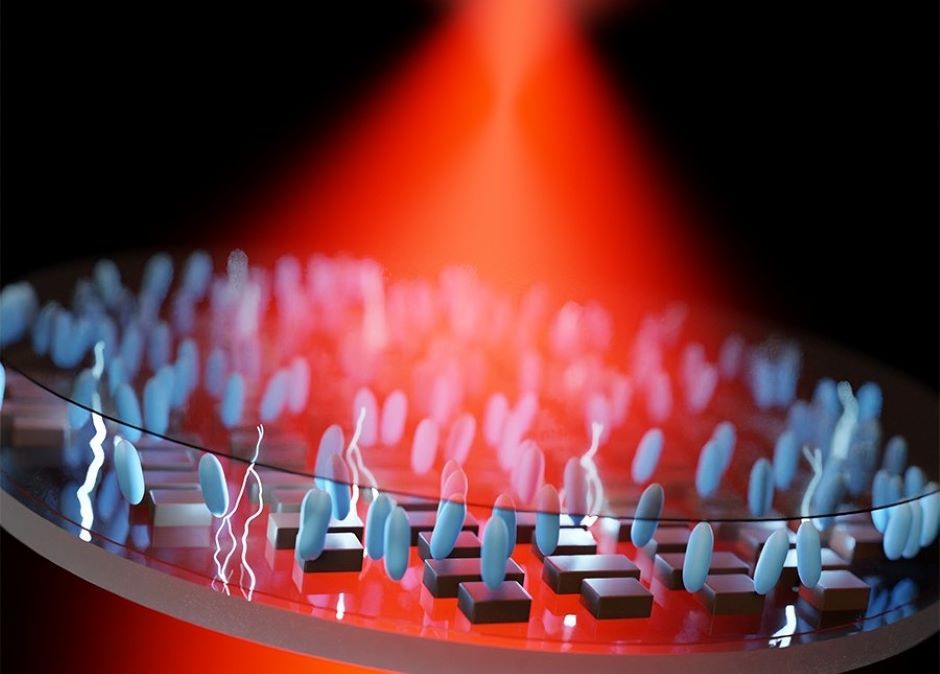A team of astronomers might have discovered a “Giant Arc” of galaxies in deep space that would challenge our understanding of cosmology.




Researchers have developed a metalens that is focused using voltage instead of mechanically moving its components, a development that promises to save space and weight in numerous imaging applications.
The advance from researchers at Cornell University’s School of Applied and Engineering Physics and Samsung’s Advanced Institute of Technology is said to be the first of its kind.
The proof of concept could lead to a range of compact varifocal lenses for use in imaging applications including satellites, telescopes and microscopes, which traditionally focus light using curved lenses that adjust using mechanical parts. In some applications, moving traditional glass or plastic lenses to vary the focal distance is not practical due to space, weight or size considerations.
Thousands of researchers from more than 70 countries are developing a comprehensive map of every kind of cell in the human body, an endeavor that could transform our understanding of diseases and medicine.
#Moonshot #Science #BloombergQuicktake.
——-
Like this video? Subscribe: https://www.youtube.com/Bloomberg?sub_confirmation=1
Become a Quicktake Member for exclusive perks: https://www.youtube.com/bloomberg/join.
QuickTake Originals is Bloomberg’s official premium video channel. We bring you insights and analysis from business, science, and technology experts who are shaping our future. We’re home to Hello World, Giant Leap, Storylines, and the series powering CityLab, Bloomberg Businessweek, Bloomberg Green, and much more.
Subscribe for business news, but not as you’ve known it: exclusive interviews, fascinating profiles, data-driven analysis, and the latest in tech innovation from around the world.
Visit our partner channel QuickTake News for breaking global news and insight in an instant.

The high-lift wing shapes are more aerodynamic than conventional aircraft, giving the SE200 more efficiency and shorter takeoff and landing capabilities. Courtesy SE Aeronautics.
SE points to its integrated monocoque structure as a breakthrough for performance and safety. The company notes aircraft manufacturers bolt together large sections called “barrels,” in order to maximize production. “This is usually where fuselages break apart in an accident,” SE says. “SE will build a single-piece, tough composite fuselage.”
The monocoque design and composite materials will make the aircraft the most efficient ever built, claims the company, with a 50-year service life. “We will also be able to build these aircraft in less than half the time it takes to normally build an aircraft of its size,” it says.


Circa 2015
With the 2015 Chevrolet Impala Bi-Fuel, drivers can top off their tank with waste byproducts, almost like Dr. Emmett Brown — aka “Doc” — did with his time-traveling DeLorean in the movie “Back to the Future.”
But instead of dumping banana peels and backwash from a beer can directly into the DeLorean’s “Mr. Fusion” reactor (see the video clip below), Impala Bi-Fuel owners simply fill up on natural gas, some of which comes from biogas, Chevy points out in its announcement about the new full-size sedan arriving in dealerships soon.
Biogas is derived from the methane that microrganisms emit after breaking down organic waste material in an oxygen-less environment. The process is called anaerobic digestion.

NASA is already so impressed by the Starship that it has contracted SpaceX to build a lunar-landing version of it to return astronauts to the moon as early as 2024. The selection has enraged Musk’s rivals such as Blue Origin’s Jeff Bezos  Jeffrey (Jeff) Preston BezosSeat on Bezos-backed space flight sells for million at auction Researchers: Wealth accumulation at Ivy League presents ‘fundamental threat to our democracy’ Democrats reintroduce bill to create ‘millionaires surtax’ MORE and has perturbed some members of Congress. Both have only themselves to blame — Blue Origin for offering an inferior design and Congress for underfunding the Human Landing System project.
Jeffrey (Jeff) Preston BezosSeat on Bezos-backed space flight sells for million at auction Researchers: Wealth accumulation at Ivy League presents ‘fundamental threat to our democracy’ Democrats reintroduce bill to create ‘millionaires surtax’ MORE and has perturbed some members of Congress. Both have only themselves to blame — Blue Origin for offering an inferior design and Congress for underfunding the Human Landing System project.
Military technology development has often been defined by the advent of new ways to transport people and cargo. The racing galleon of the 16th century became the frigates and ships of the line that defined naval warfare in the 18th and early 19th centuries. The steam engine and iron and steel armor led to the dreadnoughts of the early 20th century. Modern warships incorporate nuclear power. Air travel has caused the same sort of evolution, from the motorized kites of World War I to modern jets that can deliver destruction and death from thousands of miles away.
Now, space transportation technology is poised to cause a similar revolution in the military’s ability to defend the United States and its allies and to inflict mayhem and death on any enemy that would propose to make war on America. The great irony is that the Starship will be used by a branch of the military that Musk once compared to Starfleet, the fictional service depicted in the “Star Trek” television shows and movies. The thought would likely bring a smile to the face of the franchise’s creator, Gene Roddenberry, in whatever afterlife one envisions him inhabiting.

